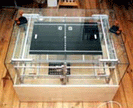
« PREVIOUS ENTRY
A lamp that’s happy to see you
NEXT ENTRY »
Brake lights: the next generation

This is flat-out awesome: Some German geeks have created a playable version of Pong that is driven not by microchips but by old-school physical relays. Instead of silent silicon transistors mysteriously flipping bits back and forth, this game presents you with the fully sensual click and clatter of magnetic relays turning on and off — flipping bits in the most primordial fashion possible. As they put it on their web site:
Pongmechanik is an electromechanical conversion of the classical game Pong. And instead of more realistic graphics, it ever accurately to reproduces the original Pong. The user is hardly changed. However the game breaks open the Black box: What takes place in the computer, becomes again perceptible and comprehensible.
This, to me, is a really important art project. Today’s computer users (and even many programmers) have no serious idea of how computer logic works: Unless you actually look at their schematics, computer chips are silent and utterly mysterious, as physically inscrutable as the monolith in 2001: A Space Odyssey. But computer logic is not at all hard to understand when you replicate it using physical relays — which one can visually see turning on and off. Back in grade seven in 1980, I found a book in my library showing how to build logic gates out of magnetic relays. I went to Radio Shack, bought about 20 relays, and spent the next few months building increasingly complex logical operations, including little adders that could calculate the sums of binary numbers. My parents thought I’d gone insane.
My favorite moment was when I built a flip-flop gate — the basis of computer RAM. It’s just a simple feedback operation: You click a switch that activates a set of relays that begin feeding electricity back to themselves, so they remain eternally on. (They’ll only turn off if you run out of electricity or if you purposely “erase” the memory by actively breaking the circuit.) I built a flip-flop circuit, flipped the switch, watched the relay click on and remain on. It was a trippy, Frankensteinan moment. I’d created a piece of memory — a device that seemed to display some tiny piece of self-consciousness. Very heady stuff when you’re 10 years old!
At any rate, when I started using computers a few years later, I had a reverse-Matrix experience with them: When I ran a program I could imagine it as this enormous football field of electromagnetic relays clacking on and off, the logic muttering to itself like a chorus of crickets at night. It demystified computers a bit, and I think that’s important, because the less you believe that computers are boxes filled with magic elves, the less you’re likely to believe the snake-oil crap that hardware and software companies feed you.
God damn I want one of these mechanical-Pong cabinets. I wonder how much it would cost to have them build one for me? Check out pictures of the device here, and video of it in action here.
It occurs to me that the flip-flop gate takes on an unintentionally lovely resonance in our current political context. President Bush likes to attack John Kerry for being a “flip-flopper” — for changing his mind — arguing that to do so is a sign of weakness and indecision. In a computer context, the metaphor is precisely reversed: Without the ability to change its state, a bit means nothing; without flip-flopping, a computer can neither remember anything nor accomplish anything.
(Thanks to Slashdot for this one!)
I'm Clive Thompson, the author of Smarter Than You Think: How Technology is Changing Our Minds for the Better (Penguin Press). You can order the book now at Amazon, Barnes and Noble, Powells, Indiebound, or through your local bookstore! I'm also a contributing writer for the New York Times Magazine and a columnist for Wired magazine. Email is here or ping me via the antiquated form of AOL IM (pomeranian99).

ECHO
Erik Weissengruber
Vespaboy
Terri Senft
Tom Igoe
El Rey Del Art
Morgan Noel
Maura Johnston
Cori Eckert
Heather Gold
Andrew Hearst
Chris Allbritton
Bret Dawson
Michele Tepper
Sharyn November
Gail Jaitin
Barnaby Marshall
Frankly, I'd Rather Not
The Shifted Librarian
Ryan Bigge
Nick Denton
Howard Sherman's Nuggets
Serial Deviant
Ellen McDermott
Jeff Liu
Marc Kelsey
Chris Shieh
Iron Monkey
Diversions
Rob Toole
Donut Rock City
Ross Judson
Idle Words
J-Walk Blog
The Antic Muse
Tribblescape
Little Things
Jeff Heer
Abstract Dynamics
Snark Market
Plastic Bag
Sensory Impact
Incoming Signals
MemeFirst
MemoryCard
Majikthise
Ludonauts
Boing Boing
Slashdot
Atrios
Smart Mobs
Plastic
Ludology.org
The Feature
Gizmodo
game girl
Mindjack
Techdirt Wireless News
Corante Gaming blog
Corante Social Software blog
ECHO
SciTech Daily
Arts and Letters Daily
Textually.org
BlogPulse
Robots.net
Alan Reiter's Wireless Data Weblog
Brad DeLong
Viral Marketing Blog
Gameblogs
Slashdot Games